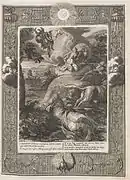In Greek mythology, Siproites (/sɪprˈɔɪtɪs/; sip-ROY-teez; Greek: Σιπροίτης, translit. Siproítēs) or Siproetes is the name of a Cretan hero, who saw the goddess Artemis naked while she was bathing and was then transformed into a woman, paralleling the story of the hunter Actaeon.[1][2]
Mythology
Siproites, while hunting, saw Artemis bathing naked; in response to the offence, the virgin goddess turned him into a woman.[3] The myth is narrated in a single line:
The Cretan, Siproites, had also been turned into a woman for having seen Artemis bathing when out hunting.[4][5]
The full story of Siproites has been lost to time; the above passage is all that remains, as Antoninus Liberalis alone preserves the tale in a brief mention within the context of a different myth, in which a Cretan woman named Galatea lists various occasions of gods changing the gender of mortals while begging the goddess Leto to change her daughter Leucippus into a boy, so that the girl's father Lamprus who wished for a son will not kill her.[6][7]
Symbolism
This sex-change tale shares similarities with the myth of Athena blinding Tiresias for seeing her naked,[8] as well as the story of Actaeon, who saw Artemis naked and was transformed into a stag that was hunted down and devoured by his own hunting dogs; it has been noted that in comparison to Actaeon, Artemis was rather lenient toward Siproites for the same offence.[9] The sex-reversal story brings its hero Siproites into line with several other male hunters and soldiers who were emasculated by a goddess, both literally and metaphorically, such as Attis and Orion.[10] In Greek mythology female-to-male transformation is treated as a positive outcome and solution to a problem, whereas the opposite situation where a man is transformed into a woman, which is the case for Siproites and Tiresias, is a negative experience and synonymous with punishment.[11]
See also
Notes
- ↑ Wright, Rosemary M. "A Dictionary of Classical Mythology: Summary of Transformations". mythandreligion.upatras.gr. University of Patras. Retrieved January 3, 2023.
- ↑ Roscher 1909, p. 950.
- ↑ "Ludwig Preller: Griechische Mythologie I - Theogonie, Götter". www.projekt-gutenberg.org (in German). Retrieved 2021-11-12.
- ↑ Antoninus Liberalis, Metamorphoses, Leucippus: "μεταβαλεῖν δὲ καὶ τὸν Κρῆτα Σιπροίτην, ὅτι κυνηγετῶν λουομένην εἶδε τὴν Ἄρτεμιν."
- ↑ Patsi-Garin 1969, p. 677.
- ↑ Celoria 1992, p. 83.
- ↑ Krappe, Alexander Haggerty (1928). "Teiresias and the Snakes". The American Journal of Philology. 49 (3): 269–70. doi:10.2307/290092. JSTOR 290092. Retrieved October 9, 2023.
- ↑ Fontenrose 1981, p. 125.
- ↑ Hard 2004, p. 192.
- ↑ Forbes Irving 1990, p. 89.
- ↑ Frontisi-Ducroux, Françoise (2009). "L'invention de la métamorphose" [The Invention of Transformation]. Rue Descartes (in French). 64 (2): 8–22. doi:10.3917/rdes.064.0008. ISSN 1144-0821. Retrieved August 15, 2023.
References
- Antoninus Liberalis, The Metamorphoses of Antoninus Liberalis, translated by Francis Celoria (Routledge 1992). Online version at topos text.
- Celoria, Francis (1992). The Metamorphoses of Antoninus Liberalis: A Translation with a Commentary. Canada, USA: Routledge. ISBN 0-415-06896-7.
- Fontenrose, Joseph Eddy (1981). Orion: The Myth of the Hunter and the Huntress. Berkeley, Los Angeles: University of California Press. ISBN 0-520-09632-0.
- Forbes Irving, Paul M. C. (1990). Metamorphosis in Greek Myths. Oxford Classical Monographs. Oxford, New York, Toronto: Oxford University Press, Clarendon Press. ISBN 0-19-814730-9.
- Hard, Robin (2004). The Routledge Handbook of Greek Mythology: Based on H.J. Rose's "Handbook of Greek Mythology". Psychology Press. ISBN 9780415186360.
- Patsi-Garin, Emmy (1969). Επίτομο λεξικό Ελληνικής Μυθολογίας [Epitomic Dictionary of Greek Mythology] (in Greek). Athens: Χάρη Πάτση publications.
- Roscher, Wilhelm Heinrich (1909). Ausführliches Lexikon der griechischen und römischen Mythologie [Detailed dictionary of Greek and Roman mythology] (in German). Vol. IV. Leipzig: Teubner-Verlag.
.jpg.webp)
.jpg.webp)
